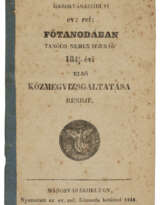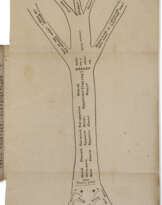ID 1129624
Lot 6 | Kurzer Grundriss eines Versuchs I. Die Arithmetik […] II. In der Geometrie
Estimate value
$ 7 000 – 10 000
First edition of the work which contains the first detailed examination and comparison of the non-Euclidean geometries of Nikolai Ivanovich Lobachevsky and the author’s son János Bolyai. We are able to trace just one other copy in auction records.
Farkas Bolyai was a student of mathematics in Göttingen, where he met and studied with Gauss and became a close and lifelong friend and correspondent; Gauss considered Farkas the only man who fully understood his metaphysics of mathematics. While at Göttingen, Gauss and Farkas discussed the problems of the parallel postulate, and later, in 1804, Farkas sent Gauss a manuscript on the subject, titled Theoria parallelarum. Farkas Bolyai "can be taken as a precursor of Gottlob Frege, Pasch, and Georg Cantor; but, as with many pioneers, he did not enjoy the credit that accrued to those that followed him" (DSB). After returning to Hungary from Göttingen, Farkas continued working on the parallel postulate. The more he tried to construct a proof of the 11th axiom, the more he came “to doubt the possibility of a demonstration and to conceive the possibility of doing away with the Euclidean hypothesis. He asserted that the results derived from the denial of Axiom XI could not contradict the principle of geometry, since the law of the intersection of two straight lines, in its usual form, represents a new datum, independent of those which precede it” (Roberto Bonola, Non-Euclidean Geometry, pp.60-61). But it was Farkas’s son, János, who, along with Lobachevsky, was to achieve the breakthrough, along with Lobachevsky, of a rigorously sound non-Euclidean geometry. János Bolyai and Lobachevksy devised differing systems independently. János preceded Lobachevsky, having completed the draft Appendix in 1825, when it was sent by his father to Gauss. However, it was only published as part of the first volume of his father’s work, in 1832, whereas the first part of Lobachevsky’s work appeared in 1829. The epochal significance of the work of these two was to remain largely unappreciated until the beginning of this century when it provided the mathematical basis for relativity theory.
The present copy bears the ownership inscriptions of Paul Stäckel and Franz Schmidt, editors of the correspondence between Bolyai and Gauss published in 1899. Stäckel considered this work of prime importance, and published it in his critical edition of the non-Euclidean writings of the Bolyais.
Octavo (199 x 118mm). (Minor repairs to gutter of title.) Original plain blue-gray wrappers (lightly creased, small stain on lower wrapper, rebacked). Provenance: Paul Stäckel (German mathematician and editor of the Bolyai-Gauss correspondence, 1862-1919; inscription on title dated October 1894, pencil annotations in his hand) – Franz Schmidt (architect and editor of the Bolyai-Gauss correspondence, d.1901; inscription on title) – inscription on upper wrapper identifying Bolyai as the author.
| Artist: | Farkas Bolyai (1775 - 1856) |
|---|
| Artist: | Farkas Bolyai (1775 - 1856) |
|---|
| Address of auction |
CHRISTIE'S 20 Rockefeller Plaza 10020 New York USA | ||||||||||||||
|---|---|---|---|---|---|---|---|---|---|---|---|---|---|---|---|
| Preview |
| ||||||||||||||
| Phone | +1 212 636 2000 | ||||||||||||||
| Fax | +1 212 636 4930 | ||||||||||||||
| Conditions of purchase | Conditions of purchase | ||||||||||||||
| Shipping |
Postal service Courier service pickup by yourself | ||||||||||||||
| Payment methods |
Wire Transfer | ||||||||||||||
| Business hours | Business hours
|
![Kurzer Grundriss eines Versuchs I. Die Arithmetik […] II. In der Geometrie - photo 1 Kurzer Grundriss eines Versuchs I. Die Arithmetik […] II. In der Geometrie - photo 1](/assets/image/picture_3695444/a8626/eadbg48uqsbtyju1n4lvfepuz3tr1owekdzuohdxgbdeouha0gibqo77ffhjfjr11704446084jpg__fix_555_460.jpeg)
![Kurzer Grundriss eines Versuchs I. Die Arithmetik […] II. In der Geometrie - photo 2 Kurzer Grundriss eines Versuchs I. Die Arithmetik […] II. In der Geometrie - photo 2](/assets/image/picture_3695445/cd5a4/k-pzfarbfdzfvfty7wsqjfoa4cy9ndgc-1irqgt1mapielaqq-h18j1nfg9jzc21704446084jpg__fix_555_460.jpeg)






![Kurzer Grundriss eines Versuchs I. Die Arithmetik […] II. In der Geometrie - photo 1 Kurzer Grundriss eines Versuchs I. Die Arithmetik […] II. In der Geometrie - photo 1](/cache/lot/1129624/eaDbG48uqSBtyjU1n4lVFepUz3tr1oWEkdZUOhDxGBDEoUHa0Gibqo77FfHjFjR1_1704446084-80x80_center_50.jpg)
